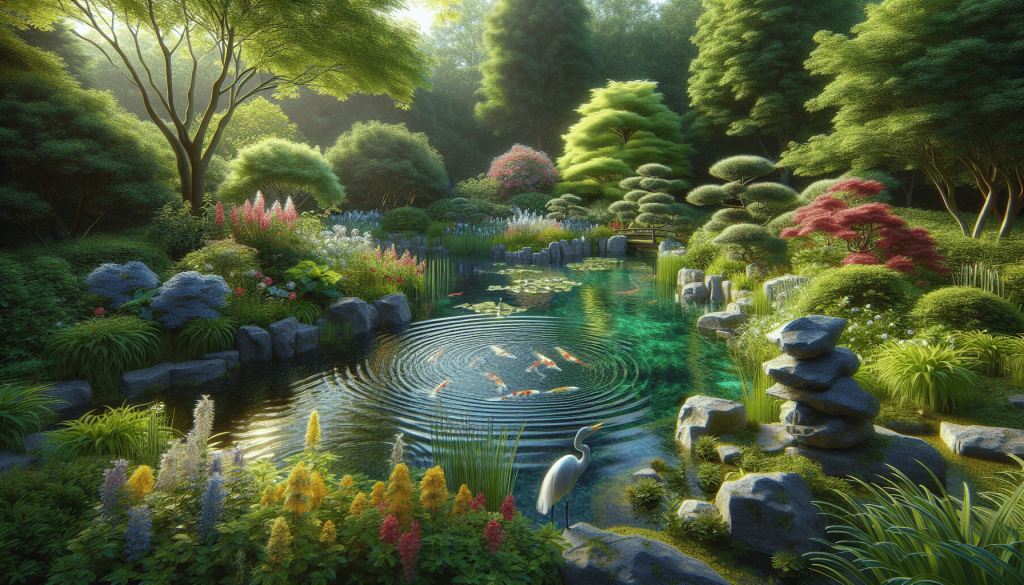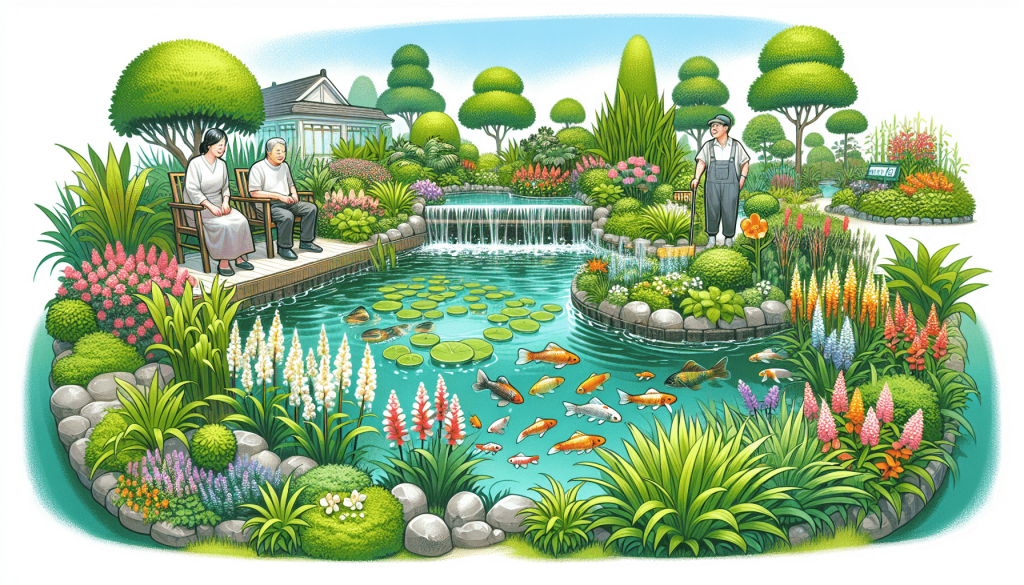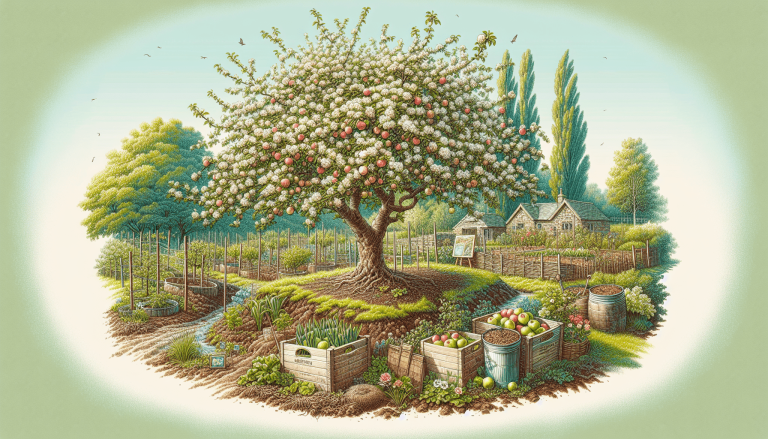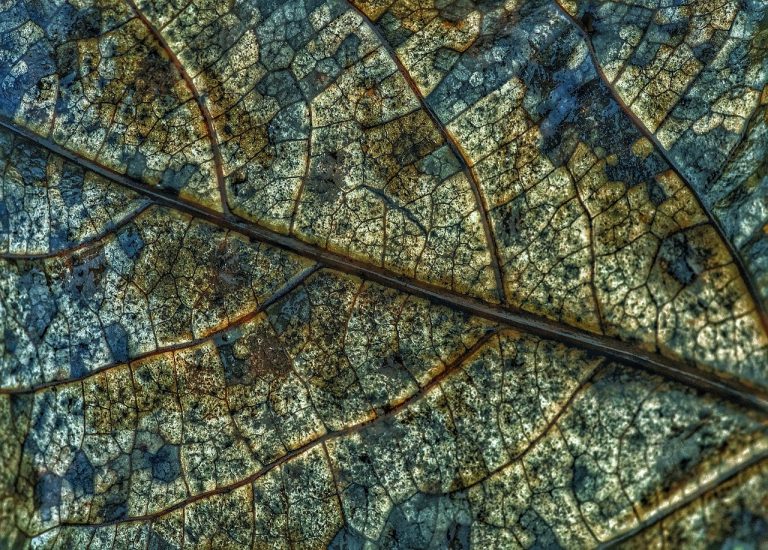You love the tranquil beauty of your garden pond and water features, but keeping them well-maintained can sometimes feel like a challenge. Fret not, for we have compiled a collection of helpful tips to help you keep your garden oasis in pristine condition. From regular cleaning and vegetation management to proper filtration and maintaining water quality, these simple yet effective suggestions will ensure that your garden ponds and water features continue to thrive and bring you joy for years to come. Whether you are a seasoned gardener or just starting out, these tips will surely prove invaluable in your quest for a picturesque and vibrant outdoor space.
Table of Contents
ToggleRegular Cleaning
Remove debris
Regularly removing debris from your garden pond is essential for maintaining its overall cleanliness and health. This includes removing fallen leaves, twigs, and any other organic matter that may have found its way into the water. You can use a skimmer net or a pond vacuum to effectively remove any debris. By keeping the pond free from debris, you not only prevent it from clogging your filters but also reduce the risk of nutrient buildup and algae growth.
Inspect and clean filters
Your pond filters play a vital role in keeping the water clean and clear by removing dirt, debris, and other impurities. It is important to inspect your filters regularly to ensure they are in good working condition. Clean or replace the filter media as needed, following the manufacturer’s instructions. By maintaining clean filters, you provide optimal conditions for a healthy pond environment.
Clean algae buildup
Algae growth is a common occurrence in garden ponds and can negatively impact the clarity and overall health of the water. Regularly inspecting and cleaning any algae buildup is crucial to prevent it from taking over your pond. You can use a brush or an algae scraper to gently scrub away the algae from the pond walls and other surfaces. Additionally, introducing algae-eating fish or adding floating plants, like water lettuce or water hyacinth, can help control algae growth naturally.
Water Quality
Test water regularly
Maintaining proper water quality is essential for the health of your pond and its inhabitants. Testing the water regularly allows you to monitor crucial parameters such as pH levels, ammonia, and nitrite levels. This can help you identify any imbalances or potential issues before they turn into major problems. There are water testing kits available that make the process simple and accurate, allowing you to take appropriate actions to maintain the optimal water quality.
Maintain proper pH levels
The pH level of your pond water affects the overall health and well-being of your aquatic plants and wildlife. It is important to maintain a suitable pH range, typically between 6.8 and 7.6, to ensure the survival of your plants and the optimal functioning of biological processes. If the pH level deviates from the desired range, you can use pH adjusters specifically designed for ponds to bring it back to the appropriate level. Regularly monitoring and adjusting the pH level will help create a stable and healthy aquatic ecosystem.
Monitor ammonia and nitrite levels
Ammonia and nitrite levels are critical indicators of water quality in your pond. High levels of ammonia and nitrites can be harmful to your fish and other aquatic life, leading to stress or even death. Regularly monitoring these levels and taking corrective actions if necessary can prevent harmful effects. Introducing beneficial bacteria in your pond can help in the natural breakdown of ammonia and nitrites, promoting a healthy environment for your aquatic inhabitants.
Plants and Wildlife
Choose suitable aquatic plants
Selecting suitable aquatic plants for your garden pond not only adds aesthetic appeal but also contributes to its overall health. Consider the specific needs of different plants, such as their sun and shade requirements, growth habits, and water depth preferences. Incorporating a variety of plants, including submerged, floating, and marginal plants, helps create a balanced ecosystem and provides shelter for wildlife. Research and choose plants that are native to your region, as they are often more adaptable and require less maintenance.
Control algae growth with floating plants
Algae growth is a common challenge in garden ponds, but you can help control it by introducing floating plants. Floating plants like water hyacinth and water lettuce shade the water surface, reducing the amount of sunlight available for algae to thrive. They also compete for nutrients, limiting the resources available for algae growth. By strategically placing floating plants in your pond, you can help maintain a healthy and balanced environment for your aquatic life.
Provide shelter and food for wildlife
A garden pond can attract a variety of wildlife, including birds, frogs, and beneficial insects. To encourage their presence and provide an inviting habitat, include features that offer shelter, such as submerged rocks, vegetation, and floating islands. These elements create safe spaces for wildlife, allowing them to rest, hide, and breed. Additionally, consider adding a bird feeder or incorporating plants that produce seeds or fruits to provide a source of food. By supporting wildlife, you enhance the biodiversity and natural balance within your pond ecosystem.
Pump and Fountain
Check and clean pump regularly
The pump is one of the essential components of your garden pond, as it circulates and oxygenates the water. Regularly checking and cleaning your pump ensures its optimal performance and prevents potential issues. Inspect the pump for any debris or clogs, and remove them carefully. Cleaning the pump impeller and housing can help maintain its efficiency and prevent blockages. Following the manufacturer’s instructions, you can perform routine maintenance tasks to keep your pump in excellent working condition.
Monitor water flow
Monitoring the water flow in your pond is crucial for both aesthetic and functional reasons. A consistent and adequate water flow helps maintain proper oxygenation levels and prevents stagnation, which can lead to poor water quality and potential health issues for your fish and plants. Regularly check the water flow rate and adjust it as necessary, ensuring that all areas of the pond receive adequate circulation. Proper water flow also enhances the visual appeal of any fountains or water features you may have, creating a tranquil and soothing atmosphere.
Maintain fountain or water feature
If you have a fountain or water feature in your garden pond, proper maintenance is necessary to ensure its longevity and functionality. Regularly clean the fountain or water feature to remove any buildup of algae, dirt, or debris. Inspect and replace any damaged parts, such as clogged nozzles or cracked pipes, to keep the water feature running smoothly. It is also essential to periodically check the water level and top it up if necessary to maintain the desired visual effect. Following a consistent maintenance routine will help preserve the beauty and functionality of your fountain or water feature.
Winter Care
Prepare for winter
Winter can pose unique challenges for your garden pond, but with proper preparation, you can mitigate potential issues. Start by removing any debris that may have accumulated in the pond before winter sets in. Trim back any overhanging plants to prevent them from falling into the water and decaying. Consider installing a pond net to catch falling leaves and prevent them from sinking to the bottom. Additionally, you may need to remove delicate or tropical plants and store them indoors for the winter. Being proactive and preparing in advance will make winter care easier and protect your pond from unnecessary damage.
Keep ice-free with a floating deicer
During the winter months, keeping your pond ice-free is essential to maintain a healthy and oxygenated environment for your fish and other aquatic life. Installing a floating deicer or pond heater can prevent the water surface from freezing completely, allowing gas exchange and avoiding the buildup of harmful gases. The gentle heat generated by the deicer keeps a small area of the water open, providing a vital escape for accumulated gases. By using a floating deicer, you can safeguard the well-being of your pond inhabitants throughout the winter season.
Protect fish and plants from freezing
Cold temperatures can be detrimental to your fish and plants in the pond. Take precautions to protect them from freezing conditions. If your pond is deep enough, fish can overwinter at the bottom, where the water is warmer. However, if your pond is shallow or in an extremely cold climate, you may need to consider moving your fish indoors or providing an insulated enclosure within the pond. Tropical or sensitive plants should be moved indoors or stored in a frost-free area until the weather becomes more suitable. By safeguarding your fish and plants from freezing, they will be ready to flourish when spring arrives.
Fish Care
Choose fish suitable for your climate
When selecting fish for your garden pond, it is important to choose species that are suitable for your specific climate. Different fish have different temperature tolerance levels, and some may not survive in extreme heat or cold. Research the recommended temperature range for each fish species and choose accordingly. Popular choices for garden ponds include koi, goldfish, and native fish species. By selecting fish that are well-adapted to your climate, you ensure their health and longevity in your pond.
Provide adequate food
Feeding your fish a balanced and appropriate diet is essential for their growth and well-being. Different fish species have different nutritional requirements, so it is important to choose a high-quality fish food specifically formulated for pond fish. Feed your fish the appropriate amount of food, considering their size and the ambient temperature. Overfeeding can lead to water quality issues, so it is best to feed them small portions multiple times a day, allowing them to consume the food quickly. By providing adequate and nutritious food, you support the overall health of your fish and maintain a thriving pond ecosystem.
Monitor fish health
Regularly monitoring the health of your fish is crucial for detecting any potential issues early on. Observing their behavior, appearance, and feeding habits can give you valuable insights into their well-being. Look for signs of stress or disease, such as changes in appetite, unusual swimming patterns, or visible physical abnormalities. If you spot any concerns, take immediate action to address them. Consulting with a veterinarian specializing in fish health or a knowledgeable pond specialist can provide guidance and assist you in maintaining optimal fish health.
Safety Measures
Secure the perimeter
Ensuring the safety of your garden pond is essential, especially if you have young children or pets. Securing the perimeter with a barrier, such as a fence or gate, can prevent accidental falls into the water. Choose a barrier that is sturdy and has no gaps that could allow small children or animals to slip through. Regularly inspect the perimeter for any potential weaknesses or gaps, and promptly repair or reinforce them to maintain a secure environment around the pond.
Use childproof features
If you have young children or grandchildren visiting your garden, implementing childproof features around your pond adds an additional layer of safety. Consider installing childproof gates or latches on the fence surrounding the pond area. You can also place safety nets or covers over the pond to prevent access. By incorporating these measures, you create a safe environment that allows everyone to enjoy your garden without worry.
Eliminate drowning hazards
To further enhance safety around your garden pond, it is important to eliminate any potential drowning hazards. Remove any large rocks or objects near the water’s edge that could pose a risk. Trim back any overhanging vegetation that may obstruct visibility or provide a potential entanglement hazard. By being vigilant and proactive in removing potential dangers, you can minimize the risk of accidents and create a safe environment for all.
Maintenance Tools
Get the necessary tools
To effectively maintain your garden pond, having the right tools on hand is crucial. Invest in a skimmer net and a pond vacuum to remove debris from the water and clean the pond floor. These tools make the task much easier and efficient. Additionally, consider obtaining a telescoping pond rake to remove any larger debris that may be difficult to reach. Having these tools readily available will save you time and effort in maintaining the cleanliness and overall health of your pond.
Use a pond vacuum
A pond vacuum is an invaluable tool for keeping your pond floor clean and free from debris. As organic matter accumulates on the floor, it can release nutrients that contribute to poor water quality and algae growth. A pond vacuum allows you to suction away this debris without the need to drain the entire pond. By periodically using a pond vacuum, you prevent the buildup of organic material and maintain a healthier pond ecosystem.
Invest in a water testing kit
A water testing kit is an essential tool for accurately monitoring the quality of your pond water. These kits typically include tests for pH, ammonia, nitrites, and nitrates, allowing you to assess key parameters affecting the health of your pond. By investing in a water testing kit and regularly performing tests, you gain valuable insights into the condition of your pond’s water. This information enables you to take appropriate actions and make necessary adjustments to maintain optimal water quality.
Troubleshooting
Addressing leaks
Leaks can be a frustrating issue for pond owners, as they can lead to water loss and potential damage. If you suspect a leak in your garden pond, a systematic troubleshooting approach can help identify and address the problem. Start by visually inspecting the pond liner or structure for any visible tears or cracks. If you cannot identify a visible leak, you may need to perform a water loss test by measuring the water level over a period of time. Repairing a leak may involve patching the liner, applying sealant to seams, or even replacing a damaged section. Consulting a pond specialist or professional can provide guidance and expertise in resolving leaks effectively.
Dealing with excessive algae
Excessive algae growth is a common issue in garden ponds, but there are measures you can take to keep it under control. A proactive approach includes maintaining proper water quality, ensuring adequate circulation and oxygenation, and adding appropriate aquatic plants and algae-eating fish. In case of persistent algae problems, you can use algaecides specifically designed for ponds, following the instructions carefully. It is important to strike a balance, as excessive use of algaecides may harm the beneficial bacteria and other organisms in your pond. Regular monitoring and adjusting of your pond’s conditions will help prevent excessive algae growth and maintain a balanced ecosystem.
Solving pump problems
A malfunctioning or inefficient pump can disrupt the overall health and functionality of your garden pond. If you encounter any issues with your pond pump, start by checking the power supply and ensuring that it is properly connected. Inspect the pump intake for any clogs or obstructions and clean them out. If the pump still does not work as expected, it may be necessary to disassemble and clean the pump impeller or seek professional assistance. Routine maintenance, timely cleaning, and inspection of your pump can help prevent problems and ensure smooth operation.
Professional Help
Consult a pond specialist
In certain situations, seeking the advice and expertise of a pond specialist can be beneficial. If you are unsure about maintaining specific aspects of your garden pond, such as water quality management, plant selection, or fish health, a pond specialist can offer valuable guidance. They can assess your pond’s unique requirements, recommend appropriate solutions, and provide expert advice tailored to your specific needs. Consulting a pond specialist ensures that you receive accurate information and benefit from their wealth of knowledge in managing garden ponds.
Consider hiring a professional
For more complex tasks or if you simply prefer to leave the maintenance of your garden pond in the hands of professionals, hiring a professional pond maintenance service can be a wise choice. Professional pond technicians have the experience and expertise to handle a wide range of maintenance tasks, such as cleaning, water quality testing, and troubleshooting. They can efficiently address any issues that arise and ensure that your pond remains in optimal condition throughout the year. Hiring a professional takes the responsibility off your shoulders and allows you to enjoy your garden pond worry-free.
Attend workshops or classes
Attending workshops or classes related to garden pond maintenance can be an enriching experience for beginners and experienced pond owners alike. Many garden centers, nurseries, and community organizations offer educational programs focused on pond care. These workshops provide valuable insights, practical tips, and hands-on training to enhance your knowledge and skills. Participating in workshops or classes allows you to connect with other pond enthusiasts, exchange ideas, and learn from experienced professionals, further enhancing your enjoyment and success in maintaining your garden pond.








